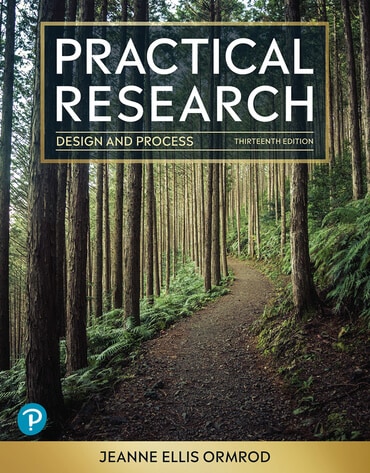
Common misconceptions about the nature of science and scientific research

Even in graduate school, many students have misunderstandings about the nature of both science and scientific research. In this brief blog post, I hope to correct certain misconceptions my readers might have about these two concepts.
What does true scientific research entail?
In Chapter 1 of the book, Practical Research: Design and Process, 13th Edition, I identify activities that do not constitute true research as scientists use the term, and they’re worth repeating here. In particular, scientific research is not simply:
- Gathering information that already exists but is currently unknown to an individual making an inquiry about a topic.
- Rummaging around for existing information that is hard to find but is important for decision-making regarding an important project or problem.
- Transporting information from one location to another — for example, by writing a “research report” that a student submits to meet a course requirement.
Instead, true scientific research is a process of systematically collecting, analyzing, and interpreting data to enhance understanding of a particular phenomenon. Let’s look at specific words within this definition:
- Scientific research is systematic — that is, it is conducted in a somewhat preplanned, organized fashion, rather than being a totally rudderless, willy-nilly endeavor. As you will see, exactly how systematic a research endeavor is depends on the research methodology being used; for example, on average, quantitative research is more preplanned and systematic than qualitative research.
- Scientific research involves collecting new data — perhaps measurements of a certain physical phenomenon, people’s responses to a certain survey, or observations of commonplace behaviors within a certain social or cultural group. (Please note an exception here: Consistent with open science practices, a researcher might make use of another researcher’s data in a quest for additional insights that those data may yield.)
- Scientific research also involves analyzing a body of data to find patterns within it — patterns that might shed light on a phenomenon that has previously been poorly understood.
- Finally, scientific research involves interpreting and trying to make sense of those data — going beyond the data themselves to draw conclusions about the underlying phenomenon being studied.
Driving the whole research endeavor are one or more research problems or questions that the researcher is trying to address and potentially solve. In Chapter 1 I describe such problems and questions, and in Chapter 2 I give you considerable guidance about how to identify appropriate ones for your own research projects.
What, exactly, is science?
When children first hear the term “science” in elementary and secondary school grades, their teachers are typically referring to biology, chemistry, physics, astronomy, and the like. But in fact, most academic disciplines — not only the biological and physical sciences, but also the psychological and social sciences — have elements of science at their core.
The helping professions, too, are rooted in science. Medicine and health care are rooted in biology, but so are education, psychotherapy, social work, coaching, and many other helping professions dependent on scientific findings.
Here I simply want to highlight three things that a scientific approach to a problem or question typically involves, plus one thing that it definitely does not involve:
- Hypothesis formation and testing: When conducting a research project, many scientists begin with one or more tentative hypotheses regarding processes or dynamics that underlie the phenomenon under investigation; they will then design a study that can enable them to systematically test those hypotheses. In some cases, however, researchers might decide not to form any hypotheses at the outset, typically in an effort to be as open-minded as possible about what the collected data might reveal. Nevertheless, in virtually all scientific research, one or more hypotheses eventually emerge as potential explanations for the phenomenon at hand, and at some point during a project, those hypotheses are tested.
- Construction of theories and/or models: Scientific inquiry is a very constructive process. Often it involves constructing or revising a theory—an integrated set of concepts and principles developed to explain a particular phenomenon. Alternatively, it might involve constructing a model—a physical or graphical representation that shows how certain entities might be interrelated parts of a larger system. As examples, you’ve undoubtedly seen physical models of the sun and various planets in our solar system, and you’ve seen graphic models of various phenomena (perhaps including cause-and-effect relationships) in college textbooks.
- Some degree of objectivity: Researchers strive to be as objective as they can in their quest to collect, analyze, and interpret data. Unfortunately, thanks to the various expectations, biases, mindsets, and worldviews that researchers inevitably bring to any research project, complete objectivity is virtually impossible. As you read the book, you’ll discover the many ways in which the human mind can distort the true “realities” of our physical, psychological, and social worlds — if such realities exist at all. You’ll also discover that, especially in the psychological and social sciences, many researchers have acknowledged that they can never be completely objective in their research findings and conclusions.
- Recognition that it is virtually impossible to prove anything beyond a shadow of a doubt: As our international scientific community increasingly adds new information to our knowledge base about various physical, psychological, and social phenomena, we can continue to zero in on things that might be true about the world and the larger universe in which we live. But for logistical and statistical reasons, we will probably never know what things are actually true. For example, as a high school student back in the 1960s, I was taught that atoms and the protons, neutrons, and electrons within them were the smallest components of the physical universe. But then along came quarks, muons, neutrinos, and other entities that are seemingly even smaller.
I should mention here that the impossibility of proving something doesn’t mean that the theories and models that scientists construct to explain their findings have no merit. As more and more data related to a particular phenomenon is collected, some theories and models are regularly revised to take that data into account; meanwhile, other theories and models might be discarded because they cannot adequately account for the new data.
Even though a given theory cannot ultimately be proven to be a complete explanation of a phenomenon, it can nevertheless have considerable usefulness in making predictions and identifying interventions that can enhance the well-being of human beings, other living things, and the planet on which we all live.
Researchers’ particular beliefs about the nature of human knowledge can have a major impact on the quality of the research they conduct, the conclusions they draw, and, ultimately, the impact they have on our communal knowledge of the world as a whole. I expand on this point in a separate blog post: “How researchers’ epistemic beliefs influence the quality of their work.”
About the author

Jeanne Ellis Ormrod, Author and Educator
Jeanne Ellis Ormrod is an educational psychologist with specializations in learning, cognition, and child development. She received a PhD and an MS in educational psychology at The Pennsylvania State University and an AB in psychology from Brown University. For many years, she was a faculty member at the University of Northern Colorado, where she taught courses in learning and cognition, educational psychology, measurement, and research methods. She is currently Professor Emerita of Psychological Sciences at UNC.



